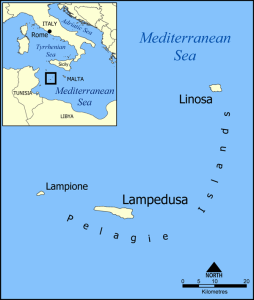Raimondo Bucher
Bucher, Raimondo
Raimondo Bucher (1912-2008) was born in the Austro-Hungarian Empire and was originally an  aviator, who took part in the Second World War. However, it was as a diver and underwater explore that he is best known. Arguably his best know discovery was the locating of the sunken Roman city of Baia in the Gulf of Pozzouli.
aviator, who took part in the Second World War. However, it was as a diver and underwater explore that he is best known. Arguably his best know discovery was the locating of the sunken Roman city of Baia in the Gulf of Pozzouli.
In 1957, Bucher discovered the ruins of what he considered to be remnants of an ancient civilisation in the vicinity of Linosa, one of the Pelagie Islands. He speculated on a possible link with Atlantis, noting “that the legend of Atlantis handed down by the Greeks just talk about a land that, in past centuries would have to be in the region of North Africa and Sicily.”(a)
(a) https://fortunadrago.wordpress.com/the-never-ending-story/colonello-c-cattoi/raimondo-bucher/
Linosa
Linosa is a small volcanic island in the Strait of Sicily, which along with Lampedusa and Lampione make up the Pelagie Islands. In 1957, Raimondo Bucher, the celebrated underwater explorer, discovered the ruins of what he considered to be remnants of an ancient civilisation in the vicinity of Linosa. He speculated on a possible link with Atlantis noting “that the legend of Atlantis handed down by the Greeks just talk about a land that, in past centuries would have to be in the region of North Africa and Sicily.”(a)
Pelagie Islands. In 1957, Raimondo Bucher, the celebrated underwater explorer, discovered the ruins of what he considered to be remnants of an ancient civilisation in the vicinity of Linosa. He speculated on a possible link with Atlantis noting “that the legend of Atlantis handed down by the Greeks just talk about a land that, in past centuries would have to be in the region of North Africa and Sicily.”(a)
(a) https://fortunadrago.wordpress.com/the-never-ending-story/colonello-c-cattoi/raimondo-bucher/
Pelagie Islands
The Pelagie Islands is the current political name of three small islands,  controlled by Italy, located between Sicily and Tunisia and are comprised of Lampedusa, Linosa and Lampione. Anton Mifsud informs us that the title was originally applied to the three islands PLUS Malta and Gozo and contends that this larger grouping constitutes the remnants of Plato’s Atlantis(b).
controlled by Italy, located between Sicily and Tunisia and are comprised of Lampedusa, Linosa and Lampione. Anton Mifsud informs us that the title was originally applied to the three islands PLUS Malta and Gozo and contends that this larger grouping constitutes the remnants of Plato’s Atlantis(b).
In the 1950s, submerged structures were claimed to have been discovered in the vicinity of Linosa by the celebrated underwater explorer, Raimondo Bucher(a). He speculated that these features may have been related to Atlantis.
>In 2015, Diego Ratti published, in Italian, a book on the prehistory of Lampedusa, Lapreistoria di Lampedusa. In 2016, He also discovered a “prehistoric underwater place of worship” off the eastern coast of the island(c), which he describes as a temple similar in layout to those found on Malta(d).
In the Introduction to a 2016 paper describing a prehistoric village on Lampedusa, Ratti wrote of “A prehistoric hut with Stentinello pottery found in Cala Pisana provided evidence for a late fifth millenium BC colonisation of Lampedusa island by people from Sicily, chronologically around the same time of the Malta early colonisation.”<
(a) https://fortunadrago.wordpress.com/the-never-ending-story/colonello-c-cattoi/raimondo-bucher/
(b) grip – Malta International Airport magazine – Jan/Feb 2006 p.44 *
(c) lampedusa-stonehenge (archive.org) *
